
|
|

March 24, 2006
Towers from the North Country: The Big Trip, 2005
Part VII: Milwaukee, Wisconsin, round one
By SCOTT FYBUSH
Once every year or so, your editor gets together with other similarly radio-crazed folk for an event that's become known as "The Big Trip" - a week (or more) of dawn-to-dusk (and sometimes beyond) traveling in search of interesting new sites to showcase here on Tower Site of the Week, in the Tower Site Calendar, and so on. It's a chance for us to meet people we've only corresponded with via e-mail, and to gather airchecks and legal IDs for our new content partners at www.tophour.net, too. (In our version of a sitcom crossover episode, we're posting the legal IDs from each Friday's Tower Site installment the following Wednesday on Tophour - check it out!)
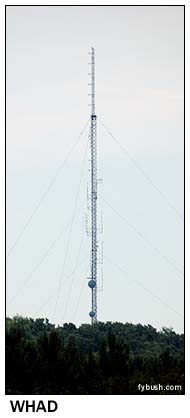 One
of the markets we were most excited about adding to our itinerary
on our August 2005 trip across Minnesota and Wisconsin was Milwaukee,
for several reasons. First, it's simply a neat market, full of
interesting directional AMs and nifty tall towers. Second, our
colleague Garrett Wollman had been through the market in July
2004, taking some
pictures that had whetted our appetite considerably. Those
pictures, in turn, started a conversation with Milwaukee TV historian
Dick Golembiewski, whose Milwaukee
TV Horror Hosts site includes a remarkably comprehensive
history of Brew City television. They also prompted invitations
from two Milwaukee broadcast engineers, Kent Winrich of Clear
Channel and Chris "Doc" Tarr of Entercom, to stop by
and see their facilities.
One
of the markets we were most excited about adding to our itinerary
on our August 2005 trip across Minnesota and Wisconsin was Milwaukee,
for several reasons. First, it's simply a neat market, full of
interesting directional AMs and nifty tall towers. Second, our
colleague Garrett Wollman had been through the market in July
2004, taking some
pictures that had whetted our appetite considerably. Those
pictures, in turn, started a conversation with Milwaukee TV historian
Dick Golembiewski, whose Milwaukee
TV Horror Hosts site includes a remarkably comprehensive
history of Brew City television. They also prompted invitations
from two Milwaukee broadcast engineers, Kent Winrich of Clear
Channel and Chris "Doc" Tarr of Entercom, to stop by
and see their facilities.
And while Garrett was working on plans for those tours, I became fascinated by reading the history of WTMJ's "Radio City" facility, the first standalone building in the U.S. designed for both radio and TV broadcasting. That prompted a phone call to the great folks at Journal Broadcast Group asking about a tour - and suddenly, our schedule in Milwaukee was packed about as full as it could get!
Our Milwaukee adventure began late on the morning of Wednesday, August 17, as we drove east from Madison. The first stop, 25 miles west of downtown, was in a state park in Delafield, home to WHAD (90.7 Delafield), the Milwaukee outlet of Wisconsin Public Radio's "Ideas" network. We couldn't get especially close to the WHAD tower, and with so many other sites beckoning us, we didn't spend a lot of time trying.
Our next two stops were in the Waukesha area, where there was a remarkable amount of road construction underway to handle all the suburban growth out that way. WAUK (1510 Waukesha) no doubt once sat on a lonely rural road. Today, it's on a little dead-end driveway behind a Wal-Mart on Les Paul Parkway, named for the musician/inventor who hails from Waukesha. WAUK is an interesting station - its 10 kW daytime signal carries ESPN Radio for Milwaukee, and when the station signs off at sunset, the sports programming moves to leased time on WMCS (1290 Milwaukee). Every ID is thus "1510 days, 1290 nights," which is a heck of a mouthful.
A couple of miles to the north, a little side road leads to the studios and transmitter site of WKSH (1640 Sussex), the Radio Disney outlet in Milwaukee. WKSH began its life as a 500-watt religious station using four towers on 1370, and the former transmitter building can still be seen at the right side of the photo below. (Garrett's 2004 pictures also show the brightly-painted studio building next to the remaining tower.)
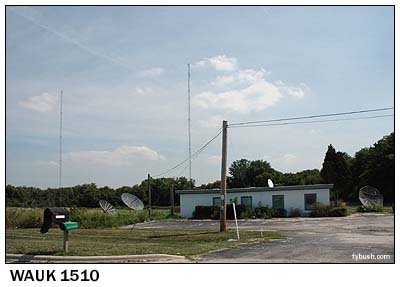 |
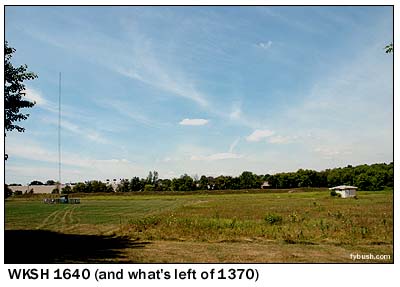
|
We're now ready to head into Milwaukee itself, and our first appointment is at WTMJ, where Kent Aschenbrenner, Journal Broadcast Group's director of engineering for the Great Lakes region, has graciously agreed to give our little band of radio history buffs an inside look at the Radio City building, on North Capitol Drive in the Shorewood section of Milwaukee, a couple of miles north of downtown.
Radio City was built in 1941 to house WTMJ radio, FM station W55M and the projected TV facilities for the Milwaukee Journal, and little expense or effort was spared to create a state-of-the-art facility for the purpose. The original facility boasted an auditorium studio that could seat nearly 400 people, as well as a mural on all four walls of the lobby designed by Jefferson Greer, the sculptor who carved Teddy Roosevelt's face on Mount Rushmore. Executed in "sgraffito," an unusual technique in which colored plaster is carved as it's applied to the wall, the mural features designs representing "sending," "receiving," "sight" and "sound." (That's "sending," there, over the reception desk on the north wall.)
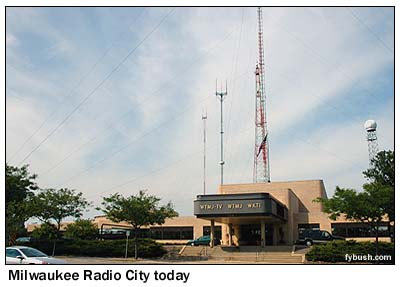
|
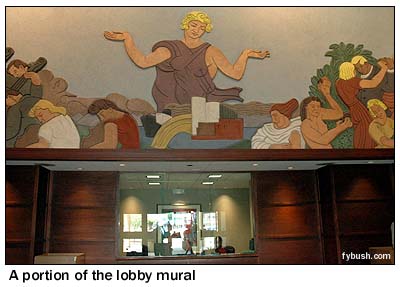
|
Before we head inside, a quick word about the towers behind the building, some of which we won't see again later on in our whirlwind tour: Directly behind Radio City are the original WTMJ-TV tower, built in 1941 and put into service in 1947, and the "new" 1035-foot WTMJ-TV tower, built in 1952 when WTMJ-TV moved from channel 3 to channel 4.
In the distance behind those towers are two candelabras owned by American Tower, which are home to Milwaukee's PBS outlets, WMVS (Channel 10) and WMVT (Channel 36), as well as WB affiliate WVTV (Channel 18) and several FM stations.
But it's history we're after here, and it's history that Radio City offers, in droves. Immediately behind the front lobby is the area that used to house the auditorium. A 1980s renovation removed the auditorium and leveled the floor, creating a big space to be filled by studios for WTMJ (620), the city's powerful news-talk voice, and by its adult contemporary sister station, WKTI (94.5), with nice windows looking out into the main corridor. There are also production studios and a newsroom for WTMJ radio back here. (Kent tells us these spaces are slated for another renovation soon.)
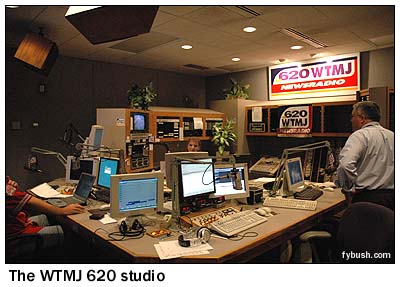
|
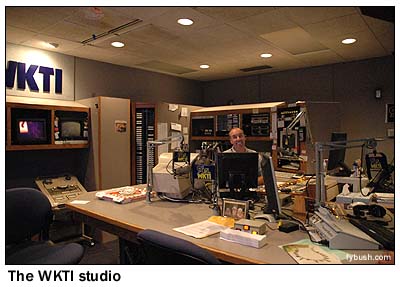
|
As we move back in the building, we move back in time, too. The original radio studios sat behind the auditorium, along tiled corridors reminiscent of an elementary school of that vintage. The offices of LMA partner WPXE (Channel 55), the Pax affiliate in town, occupied much of the space that was once the AM studio, with an old "on air" light in the hallway as a giveaway to the history. (WPXE moved out not long afterward, as Pax ended its LMAs with local stations all over the country.)
All the way back in a corner, a studio window in a storage room is one of the few clues that this space was once home to WTMJ's FM studios. WTMJ was a pioneer in FM, putting experimental station W9XAO on the air in early 1940. By 1942, the station had become W55M, with programming separate from WTMJ and with its own 50 kW transmitter site in Richfield, Wisconsin. Like so many ambitious early FM operations, WTMJ-FM struggled with the transition to the 88-108 MHz band after the war, and with the focus on TV, WTMJ-FM signed off in 1950. It returned to the air in 1959, and after running automated for a while, by the seventies it was again a vibrant separate service from the AM, under the calls WKTI.
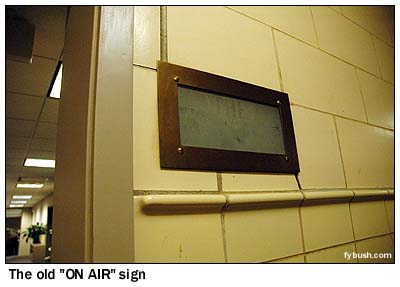 |
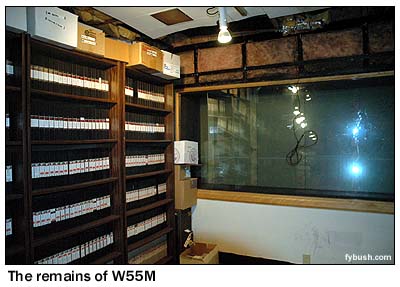
|
It didn't help W55M at all when WTMJ turned its attention rather forcefully to television after World War II, either. As early as 1930, the Journal was experimenting with mechanical television at station W9XD, operating at various times from the Journal building and from the top of the Schroeder Hotel, which would become a very important location in Milwaukee TV history. WTMJ filed the very first application for a commercial TV license, in 1938, and received an experimental construction permit in late 1940. When Radio City was being built in 1941, the Journal expected that it would soon begin commercial broadcasts there under the callsign WMJT. The outbreak of World War II stalled those plans, but with studios and a tower in place at Radio City, the Journal was able to ramp up very quickly after the war ended, putting WTMJ-TV on the air December 3, 1947 as the nation's eleventh television station. For the next six years, it would be the only TV station in Wisconsin.
The original WTMJ-TV studios were at the rear of the building, to the left of the auditorium as viewed from the street. One studio remains, used for special productions. The other is now WTMJ-TV's newsroom. In 1967, a sizable addition to the west side of Radio City created the nation's first round television studio, complete with windows looking out onto Capitol Drive.
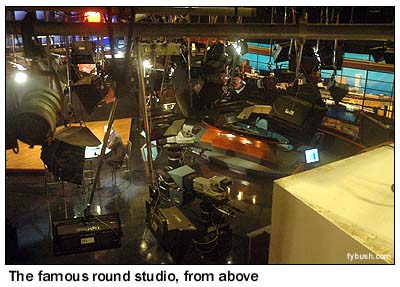 |
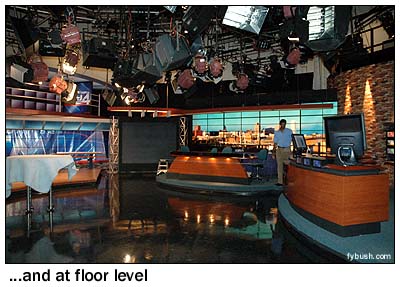
|
That studio still exists, and is still WTMJ-TV's main studio. Subsequent renovations, however, have obscured much of the roundness of the studio. The windows were covered over when they made it difficult to light the sets; a weather office was built into part of the studio (you can see a corner of that incursion in the view from above); the overhead cable system that dropped the camera cables down from the ceiling was replaced with more conventional cameras on the floor; and in the eighties, another addition to the front of the building on the east side covered up most of what was once the prominent round exterior of the studio. (That renovation, which created space now used by Journal Broadcast Group's corporate offices, also significantly altered the rest of the facade on Capitol, covering up some of the Art Deco details of the original Radio City building with a somewhat ungainly new canopy over a new front driveway.)
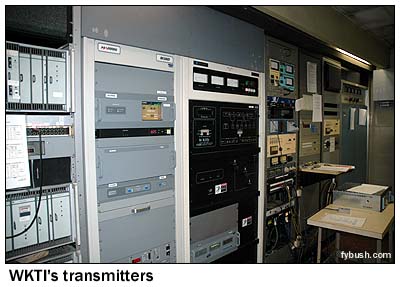 |
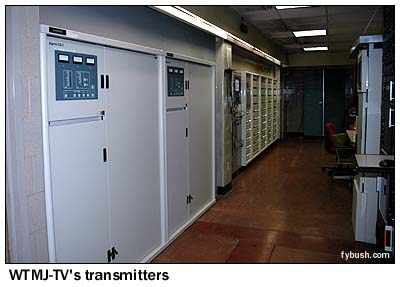
|
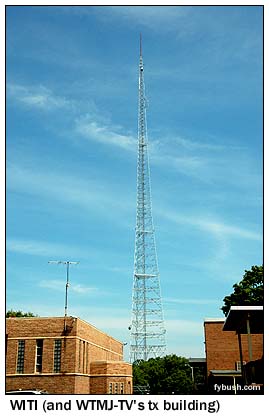
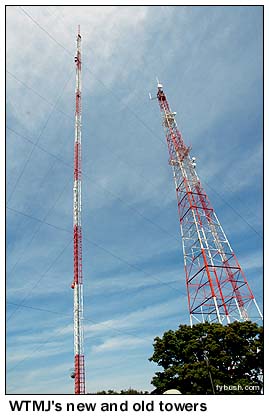 There's
a completely separate building out back that houses the transmitters
for WTMJ-TV/DT and WKTI, and you can see it in the photo at right,
which also looks east across the Milwaukee River at the mighty
self-supporting tower of WITI-TV (Channel 6).
There's
a completely separate building out back that houses the transmitters
for WTMJ-TV/DT and WKTI, and you can see it in the photo at right,
which also looks east across the Milwaukee River at the mighty
self-supporting tower of WITI-TV (Channel 6).
The 1078-foot tower is one of the tallest self-supporters in the country. It went up in 1962 to replace the original (1956) Channel 6 site, which was far to the north of Milwaukee. (The channel was originally allocated to suburban Whitefish Bay, and only later moved to Milwaukee.)
A year after it went up, WITI decided to decorate their tower with lights. Strings of 25-watt lights ran up each tower leg, spotlights were aimed at the Channel 6 antenna, and a big illuminated "6" shone from lower down on the tower. The neighbors weren't pleased at first, but the "Tower of Light" became a Milwaukee landmark after a while, until the energy crisis of 1973 forced the lights to go off. (They were eventually removed from the tower some years later. There's a great picture on Dick's site - check it out!)
So where were we? Ah yes, back across the river at the WTMJ transmitter building. Inside, a large transmitter room has WKTI's transmitters on the left and WTMJ-TV/DT in the center. It's mainly a Harris shop, except for the old RCA backup transmitter for WKTI, which is actually on the air this afternoon while the newer Harrises are being worked on. (Yes, that's an HD Radio exciter in the rack.)
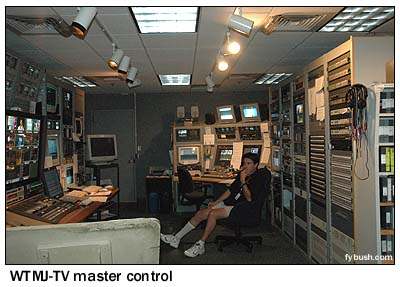 |
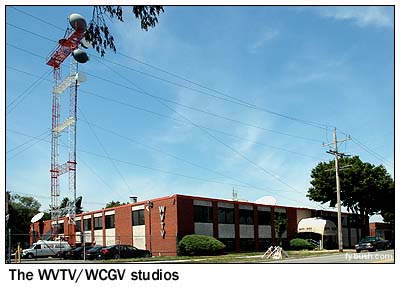
|
There's still more to see inside Radio City itself, including WTMJ-TV's ENG receive room, its TV control rooms and master control, plus some obscure little corners upstairs that were once film rooms and sponsor observation galleries and such. And Kent has a great collection of old WTMJ material in his office, which we pore over with great interest.
(One more "Radio City" note: we were especially interested in this facility because NERW's hometown of Rochester, N.Y. has its own "Radio City," the 1948-vintage facility built for WHAM radio and TV with its own auditorium studio and similar Deco detailing. We'll feature that building - now occupied by WROC-TV, the successor to WHAM-TV - in a future Site of the Week.)
With great thanks to Kent, we say our farewells and head out to see more Milwaukee sites, including a tower across the street that's home to WJZI (93.3), WMIL (106.1), WCGV (Channel 24) and WVCY-TV (Channel 30), and a few miles to the west, the studios of Sinclair's WB affiliate, WVTV (Channel 18) and UPN affiliate, WCGV, at 35th and Capitol. (Not only does this building completely lack the romance of Radio City, it's also about to be much emptier - WVTV's "News Central" newscast will go away at the end of March.)
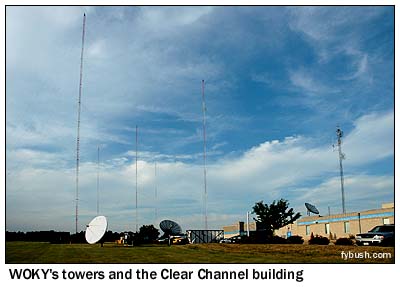 |
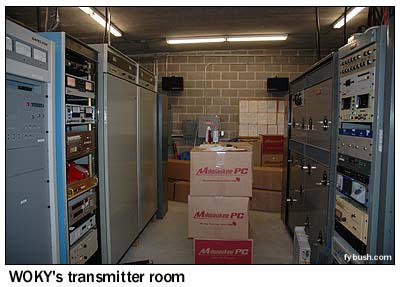
|
Our next scheduled visit is out in Greenfield, on the western edge of the market, where another Kent - Kent Winrich, K9EZ, director of engineering for Clear Channel Milwaukee - is waiting to show off his facility. The Clear Channel studios at 12100 W. Howard Avenue are right next to the five towers of WOKY (920), one of CC's two AMs in the market, and the current studio building began its life as the WOKY transmitter building. Today, the WOKY transmitters - a modern Gates Five and a much earlier predecessor - and the WOKY phasors sit in a small concrete block building behind the main building, right in the middle of the five-tower array.
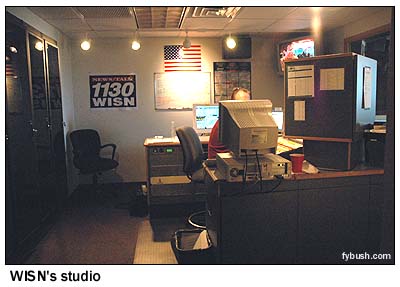 |
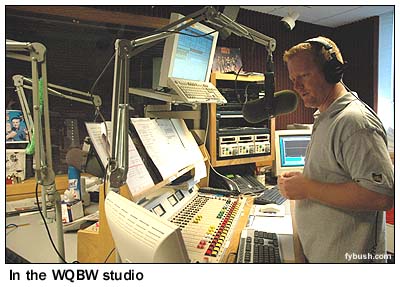
|
In the studio building, there are a lot of offices for the many stations that run out of here - standards WOKY, news-talk WISN (1130), oldies WRIT (95.7), classic hits "Brew" WQBW (97.3), urban WKKV (100.7 Racine) and country WMIL (106.1 Waukesha) - and a long row of studios running along the back wall, anchored at one end by WISN and at the other by WMIL. (Except for WISN, which needed more space for its talk format, the stations are all in order down the hall by frequency!) The music stations all have similar studios, and all but WOKY are live and local this Wednesday afternoon.
We're joined here by Entercom's Chris Tarr - and in part two of our Milwaukee experience, coming next Friday, we'll show you his nearby studio and transmitter facility, plus more of Kent's transmitters - and we'll explore more interesting moments in Milwaukee's radio history, too.
- Previous Site of the Week: The Minnesota/Wisconsin Big Trip, part VI: Madison
- Next Week: The Minnesota/Wisconsin Big Trip, Part VIII: Milwaukee, round two
- Site of the Week INDEX
- How can you help support Site of the Week? Click here!
- Submit your suggestions for a future Site of the Week!
